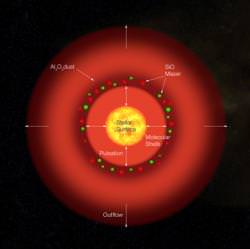When a star like our Sun reaches the end of its life – a fate we’ll face in 5 billion years – it swells up immensely, becoming a red giant star. Its size expands until it engulfs everything within the Earth’s orbit, and begins to pulsate, expending and contracting in regular intervals. Then it settles down, to live out the rest of its years as a slowly cooling white dwarf.
We’ve got 5 billion years to wait, but astronomers have found a relatively nearby star going through this very process: S Orionis, located in the constellation of Orion, and belongs to a class of Mira-type variable stars.
S Orionis pulsates with a period of 420 days. During this cycle, it changes in brightness by a factor of 500%, and changes its diameter by 20%. This ranges from 1.9 to 2.3 times the distance between the Earth and the Sun. Another way to measure this is between 400 and 500 solar radii.
During these pulsations, the star releases a tremendous amount of dust, which form into concentric rings around the star and expand outward at a speed of 10 km/s (6 miles/s). During the star’s minimum size, there’s more dust production and coronal mass ejections, and then the shell expands, releasing the material into space.
Astronomers studied S Orionis with the European Southern Observatory’s Very Large Telescope Interferometer at Paranal Observatory, Chile, using its four 8.2-metre telescopes and four 1.8-metre scopes.
Original Source: ESO News Release

